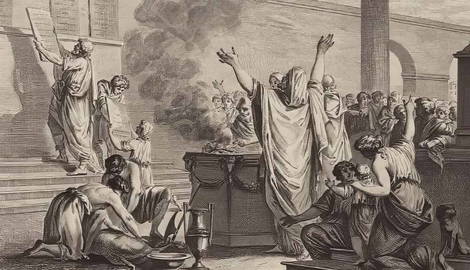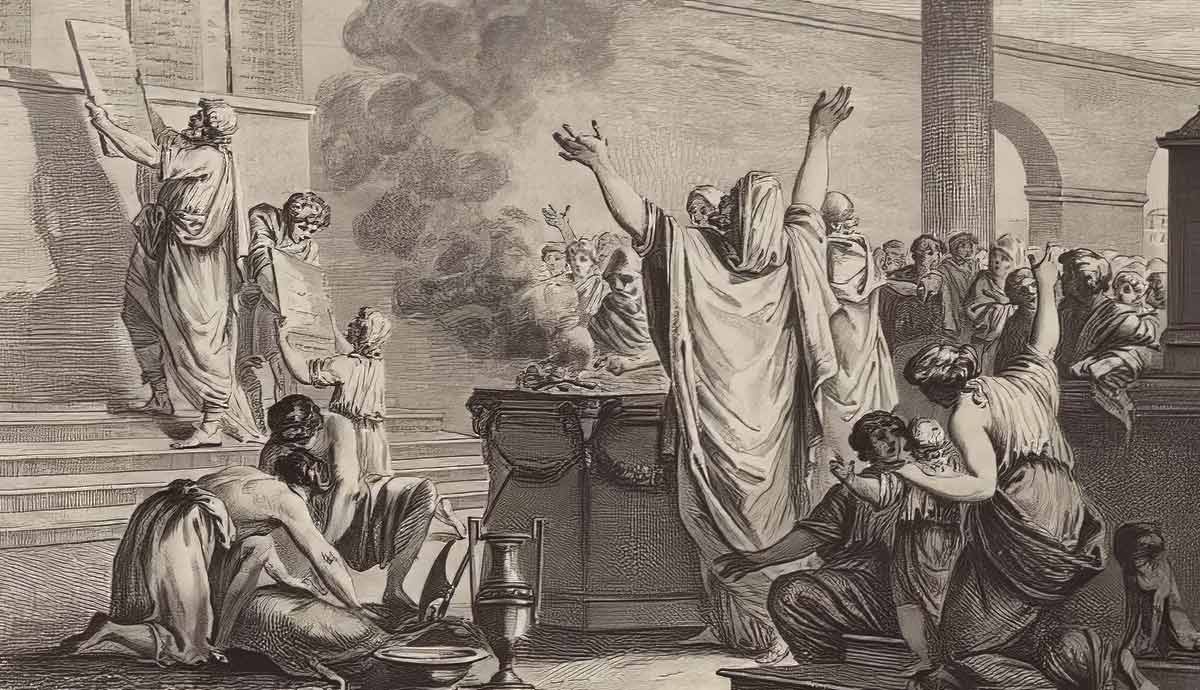
summary
- The Law of the Twelve Tables was Rome’s first public, written code—bronze tablets set up in the Forum—replacing patrician control of unwritten rules with a law every citizen could know and cite.
- Born of social conflict: Drawing on Greek models, the twelve tables covered procedure, debt, family, property, crime, religion, and class relations.
- Harsh but systematic: The code allowed lethal force against night-time thieves, chained defaulting debtors, affirmed a father’s absolute power, and matched penalties to injuries—yet its transparency and fixed wording established the principle of equal access to law.
Millennia before the Enlightenment began to seriously engage with individual human rights and modern constitutions, Rome inscribed its laws on bronze. This was the Law of the Twelve Tables, the first Roman attempt to establish order through a written code of laws. Created in the 5th century BCE, the Law of the Twelve Tables was a turning point in the history of Western law. These tables transformed the Roman Republic from a society of secret laws and self-serving interpretations into one where even the ordinary citizen could know, cite, and appeal to the law.
Why Rome Needed the Twelve Tables
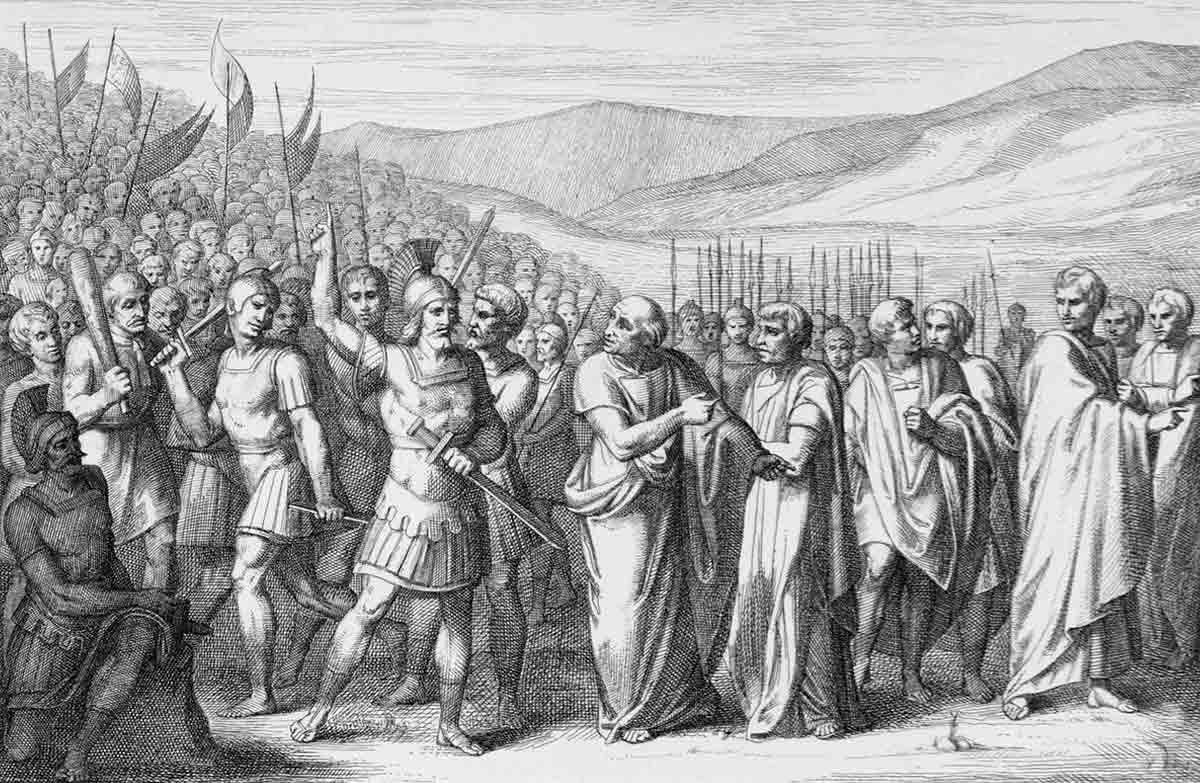
In the early days of the Roman Republic, Rome was a rapidly growing city-state plagued by numerous internal problems. Although the monarchy had been overthrown and a republic established, most power remained in the hands of the wealthy patricians, while the plebeians had very little influence on politics and legislation. This was one of the greatest frustrations of the plebeians: the law was written nowhere, and the aristocrats interpreted it to their own benefit. This dissatisfaction triggered the famous Conflict of the Orders. The plebeians demanded full rights to access the law and legal protection, not just political representation. Their argument was simple: how can a citizen respect the law if they don’t even know what the law is?
In 462 BCE, a plebeian named Gaius Terentilius Harsa proposed a radical idea: a written law that would apply to all layers of Roman society. The patricians resisted, believing that this would limit their power. However, due to increasing public pressure and nearly a decade of discussion, the Senate agreed to a compromise. A special commission was established, known as the Decemviri Legibus Scribundis, “the ten men for writing laws,” or simply the Decemviri. Their task was to travel to Greece, study their legal system, and write the first Roman laws.
What Were the Twelve Tables?

In the mid-5th century BCE, the Decemviri studied Greek law, particularly Solon’s laws, and compiled the first ten Roman tables in 451 BCE. The following year, a second group of ten Decemviri was elected, who compiled two additional tables. This is how the Law of the Twelve Tables (Lex Duodecim Tabularum in Latin) was created. The law code was engraved on bronze tablets and placed in the Roman Forum, where everyone had access to it. This is precisely where the significance of the code lies. For the first time in Roman history, the law was written down and published, allowing everyone to see it.
Although the original Twelve Tables were lost, possibly during the Gallic sack of Rome in the 4th century BCE, their content was preserved by Roman writers such as Cicero and Livy. The laws were written in concise, formulaic Latin, designed to enable both citizens and judges to easily memorize and recite them. For the Romans, the Law of the Twelve Tables was, in a way, sacred, and in Roman schools, it had to be memorized.
According to modern understanding, the Law of the Twelve Tables was brutal and merciless. For example, a thief caught at night could be legally killed, and debtors who failed to repay their debts could be imprisoned or even dismembered.
A Look Inside the Twelve Tables
What were the main aspects of Roman life in the early Roman Republic covered in the Law of the Twelve Tables?
| Tablet | Main Topics | Representative Points (examples) |
| I | Court summons & appearance | Defendant must respond; plaintiff may forcibly bring absent defendant after a witness. |
| II | Trial procedure | Morning filing, midday pleadings, judgment by afternoon; penalties for procedural violations. |
| III | Debt & insolvency | 30-day grace to repay; defaulting debtor chained for 60 days, then sold or executed. |
| IV | Paternal authority & infants | Father’s absolute power over family; severely deformed newborns to be killed. |
| V | Inheritance & guardianship | Male agnates inherit when no son; guardianship rules for women and minors. |
| VI | Property & contracts | Formal rituals (e.g., mancipatio) validate sales, land transfers, dowries, and verbal agreements. |
| VII | Land boundaries & buildings | Rules for road width, tree overhang, shared walls; damages for encroachment. |
| VIII | Torts & personal injuries | “Eye-for-eye” retaliation or fixed fines; harsher penalties for night crimes, different rates for slaves. |
| IX | Public law & treason | Capital punishment for bribery, judicial corruption, or aiding an enemy of Rome. |
| X | Sacred law & funerals | Burials outside city boundary; limits on funeral displays, mourning, and grave goods. |
| XI | Class marriage restrictions | Banned unions between patricians and plebeians (repealed by Lex Canuleia 445 BCE). |
| XII | Supplementary rules & enforcement | Clarified earlier provisions; set liability for slave misdeeds, arbitration for disputes over freedmen. |
Table I–III: Legal Procedure and Debt
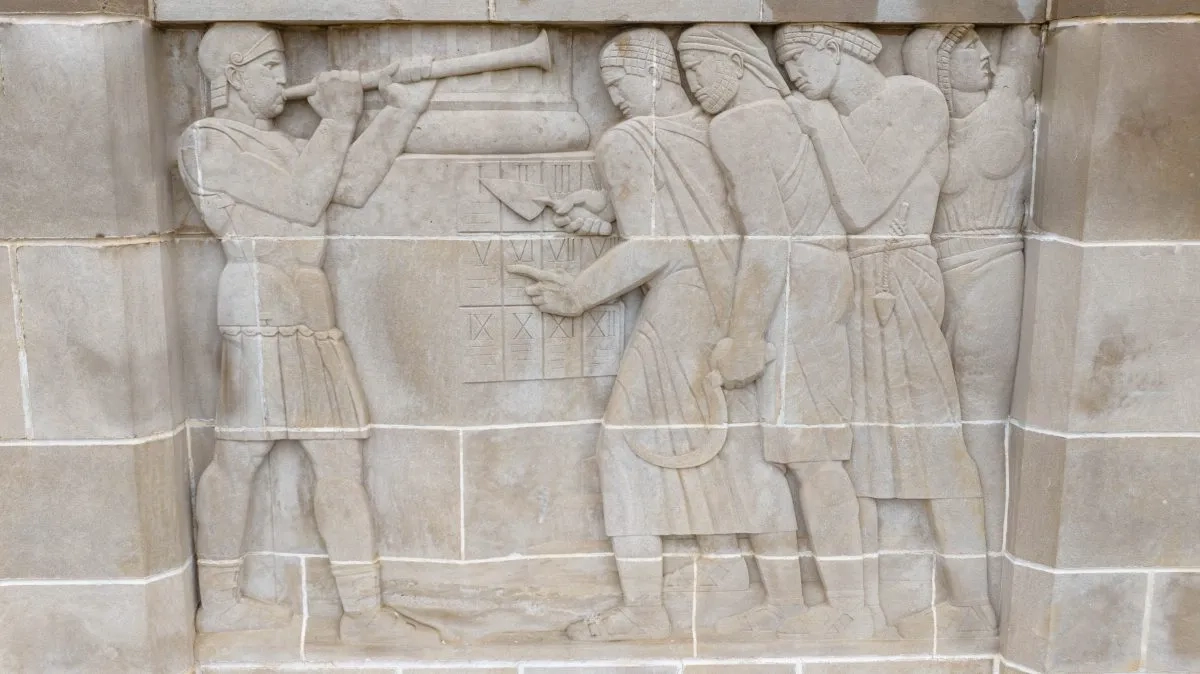
In the first three tables, the foundation of legal procedure in the Roman Republic was established. It was emphasized that every person was obligated to respond to a court summons, and if they did not go voluntarily, they would be taken by force.
“If the plaintiff summons the defendant to court the defendant shall go. If the defendant does not go the plaintiff shall call a witness thereto. Only then the plaintiff shall seize the defendant.” (I, 1)
The second table outlined the rules of trials, the selection of judges, and penalties for procedural violations. It also set a timeframe for legal cases that was much shorter compared to modern trials. All disputes had to begin in the morning and be concluded by the afternoon.
“When the litigants settle their case by compromise, let the magistrate announce it. If they do not compromise, let them state each his own side of the case, in the comitium or in the forum, before noon.” (I, 3)
The third table addressed the issue of debt and set a legal deadline of 30 days for repayment. In the case of non-payment, the debtor would be chained and taken to prison, where they would spend 60 days. Debtors were sometimes displayed in the Forum as a warning to others or even sold into slavery.
“Moreover, on the third market day they shall suffer capital punishment or shall be delivered for sale abroad across the Tiber River.” (III, 5)
Table IV–VI: Family, Property, and Inheritance

The next three tablets concerned the private lives of Roman citizens, including family relations, inheritance, and property. The patriarchal nature of Roman society is emphasized, where the father had authority over his wife, children, and slaves. He had the legal right to discipline them, and in extreme cases, even to kill them.
“A notably deformed child shall be killed immediately.” (IV, 1)
These were the brutal norms of life in antiquity, where deformities and illnesses were poorly understood and often feared.
Roman inheritance laws stipulated that property should remain with the male heir, even if there was no direct descendant, unless otherwise specified in a will.
“If there is not a male agnate the male clansmen shall have the estate.” (V, 5)
Legal acts such as marriage, the sale of land, or lending money required the presence of witnesses and traditional rituals to be considered valid. As a result, even verbal agreements were considered legally binding.
Table VII–IX: Land, Crimes, and Punishments

From the middle of the Law of the Twelve Tables, the focus shifts from family and personal relationships to broader societal issues such as land ownership, crime, and punishment. Shared spaces, roads, and even the maintenance of trees and walls between houses were regulated. The laws went into detail, including rules about how far a tree could grow into someone else’s property.
Crime was punished harshly, and there was little tolerance for any injustice done to others. The Roman understanding of justice was often based on the principle of equivalence, meaning that the punishment should match the offense. Crimes committed at night were punished more severely than those committed during the day. Likewise, punishments varied depending on whether the injustice was committed against a free person or a slave.
“If anyone has broken another’s limb there shall be retaliation in kind unless he compounds for compensation with him… If a person breaks a bone of a freeman with hand or by club, he shall undergo a penalty of 300 asses; or of 150 asses, if of a slave.” (VIII, 2/3)
One of the most striking rules in the ninth tablet of the Twelve Tables concerns the seriousness of political betrayal. Loyalty to the Republic was non-negotiable, and any act of espionage or assistance to the enemy was considered a crime worse than murder.
“Whoever incites a public enemy or whoever betrays a citizen to a public enemy shall be punished capitally.” (IX, 5)
Table X–XII: Sacred Law, Class Privilege, and Exceptions
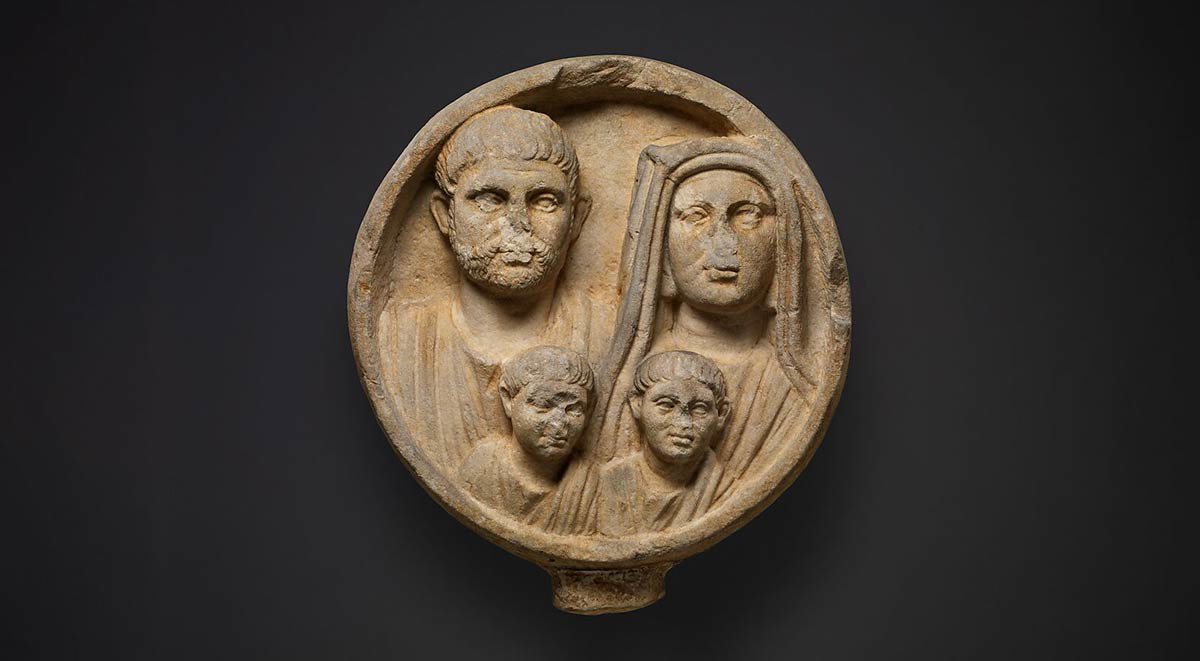
In the tenth tablet, instructions are given on how to properly handle death, burial, and mourning. In Rome, funerals were not just private family affairs but also public events, often accompanied by dramatic displays of grief and wealth. A boundary (pomerium) was established around the city. The dead were to be buried outside this boundary, and burials within the city were prohibited.
The eleventh table is perhaps the most controversial. It explicitly forbade marriage between patricians and plebeians, not for moral reasons, but to maintain a stable social order. This law caused ongoing dissatisfaction among plebeians and was the source of much debate and tension. The law was abolished in 445 BCE with the passing of the Lex Canuleia. In addition to allowing marriage between members of the two classes, Lex Canuleia established that children from such marriages would inherit the class of their father.
What Happened to the Twelve Tables?

The Twelve Tables were the first written Roman law, but they did not remain in force forever. As Roman society became increasingly complex, the Law of the Twelve Tables could no longer keep pace with new social developments. Over the following centuries, Roman law expanded through statutes (leges) passed by assemblies, edicts issued by magistrates, and decisions made by judges and legal scholars who interpreted older laws in more modern ways. By the end of the 1st century BCE, the Twelve Tables were no longer directly cited in legal proceedings.
It is not known what exactly happened to the bronze tablets, but none of them have survived. It is possible they were deliberately removed as Roman law evolved, or perhaps they were simply neglected and worn away by time. As mentioned earlier, the content of the Twelve Tables survived thanks to writers such as Cicero, Livy, Gaius (Ad legem XII tabularum), and Festus.
With the revival of Roman legal thought in the 11th century CE, particularly in Bologna, Italy, the Law of the Twelve Tables once again became relevant and gained even more significance during the Enlightenment. Thinkers such as Montesquieu and Jean-Jacques Rousseau admired the Twelve Tables for their clarity, brevity, and the principle of equality before the law.
